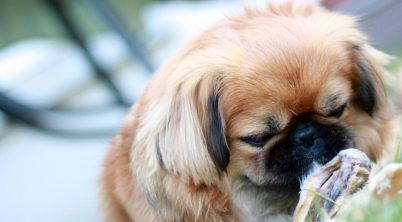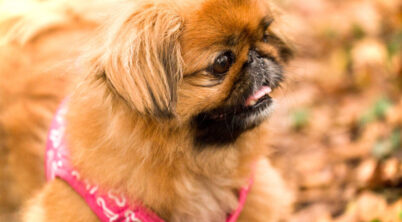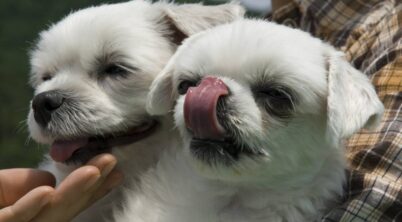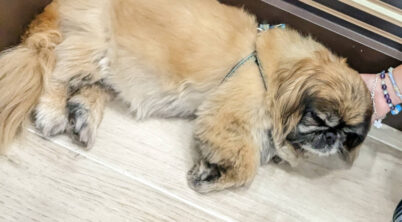The Pekingese is a breed that epitomizes dignified grace, with a history that hails from ancient China. Often recognized for their lion-like mane and confident expression, these dogs carry themselves with an air of self-assuredness that belies their small size. As a toy breed, Pekingese typically weigh between 7 to 14 pounds and stand about 6 to 9 inches tall, a size well-suited to apartment living. Their distinctive appearance and bold demeanor convey a sense of courage and boldness without the need for an extensive physical space to roam.
Despite their regal origins, Pekingese dogs have adapted well to more modest surroundings. The breed’s low exercise needs make them particularly apt for life in apartments, where their calm and loyal nature allows them to thrive in close quarters with their owners. However, prospective owners should be aware that what Pekingese lack in size, they make up for in personality; they are creatures of habit who appreciate a peaceful and stable home environment.
Care for a Pekingese in an apartment setting involves accommodating their specific needs, such as managing their thick double coat, which requires regular grooming, and addressing their moderate exercise requirements. Additionally, the breed’s sturdy build, with heavy forequarters and lighter hindquarters, does not detract from their ability to navigate smaller living spaces with ease. For city dwellers looking for a small canine companion that exudes confidence and charm, the Pekingese may be an ideal fit.
Table of Contents
Temperament and Behavior
The Pekingese is a breed with a rich heritage, often seen as both regal and dignified in its demeanor. Known for their independent nature and self-esteem, these dogs display a blend of affectionate loyalty to their family and a fierce protectiveness. They are not overly active and their energy level can be categorized as moderate, which makes them suitable companions for apartment living.
Despite their small size, Pekingese are quite bold and courageous, reflecting an almost lion-like courage. They often carry themselves with a confident and watchdog demeanor, staying alert to changes in their environment. Their protective nature makes them excellent watchdogs, as they will bark to alert their owners of unfamiliar presence.
The breed’s stubbornness and strong-willed character require consistent training and early socialization. As they are intelligent, they respond well to positive reinforcement but may resist if they feel overpowered or misunderstood. Their loving and affectionate side shines through as they bask in the company of their human counterparts, thriving on attention.
| Trait | Characteristic |
|---|---|
| Independence | High |
| Loyalty | Strong |
| Affection | Loving and demonstrative |
| Protection | Alert and attentive |
| Energy Level | Moderate |
| Intelligence | High |
| Stubbornness | Can be strong-willed |
| Social Needs | High need for companionship |
It’s imperative for potential owners to understand the Pekingese disposition for a harmonious cohabitation, especially within the confines of apartment living. The Pekingese are indeed loyal companions, their self-regard never far from the surface, yet they maintain a deep affection for their chosen humans.
Care Requirements
When discussing the care requirements of a Pekingese living in an apartment, attention must be given to their exercise needs and grooming practices to ensure they remain healthy and well-adjusted.
Exercise and Activities
The Pekingese possesses a modest energy level that suits apartment living well. They require approximately one hour of physical activity per day. This can be divided into two moderate walks, lasting about 15 to 20 minutes each, complemented with play periods to provide mental stimulation and social interaction.
- Daily Walks: Short, leashed walks starting as early as three months of age are vital for a Pekingese puppy. Adhering to a consistent walking schedule helps to manage their energy level and curbs undesirable behaviors like excessive barking.
- Exercise Requirements: While they enjoy lounging, Pekingese should not be sedentary. Tailoring exercises to their physical abilities and avoiding harsh weather conditions are necessary due to their brachycephalic nature.
- Mental Stimulation: Due to their intelligent, somewhat independent nature, mental stimulation through interactive toys or gentle play sessions is important to keep them engaged and happy.
- Training: Early socialization and obedience training, utilizing positive reinforcement methods, lay the foundation for good behavior around children and other pets.
- Grooming: A Pekingese’s long, thick coat requires daily brushing to prevent matting and to maintain overall coat health.
- Barking and Socialization: Early and ongoing socialization, paired with consistent training, helps mitigate their tendency to bark and ensures they are well-rounded companions.
Living with a Pekingese

Living with a Pekingese in an apartment context hinges on understanding their adaptability, temperament, and needs for interaction. These small dogs can be a joy or a challenge, depending on how their characteristics are managed.
Apartment Adaptability
The Pekingese thrives in apartment settings, thanks to their small size and moderate exercise requirements. They are:
- Low-maintenance: Short daily walks and indoor play suffice.
- Vocal: They make excellent watchdogs due to their alert nature.
- Attention-seekers: Regular interaction to prevent boredom.
- Socializing needs: Early socialization helps them adapt better to apartment noises and neighbors.
Despite their manageable energy levels, Pekingese require daily activities to keep them engaged and healthy. They also need training to curb excessive barking which might not be ideal in close-quarters living.
Interaction with Family
Pekingese are known for their loyalty and affectionate bond with their family members:
- Companionship: They make devoted companions and enjoy being involved in family activities.
- With kids: Supervision is needed, as they may not tolerate rough play.
- Patience: Training a Pekingese requires patience due to their independent nature.
- Attention: They thrive on attention and can sometimes be stubborn. Consistent, gentle training is key.
Their playfulness can be a source of entertainment for the family, but owners should provide structured playtimes. Regular attention not only fulfills their companionship needs but also prevents potential mischief from inactivity.








